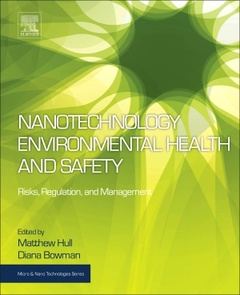Nanotechnology Environmental Health and Safety (3rd Ed.) Risks, Regulation, and Management Micro and Nano Technologies Series
Coordonnateurs : Hull Matthew, Bowman Diana

Nanotechnology Environmental Health and Safety tackles ? in depth and in breadth ? the complex and evolving issues pertaining to nanotechnology's environmental health and safety (EHS). The chapters are authored by leaders in their respective fields, providing thorough analysis of their research areas. The diverse spectrum of topics include nanotechnology EHS issues, financial implications, foreseeable risks including exposure, dosage and hazards, and the implications of occupational hygiene precautions and consumer protections.
The book includes real-world case studies, wherever practical, to illustrate specific issues and scenarios encountered by stakeholders positioned on the front-lines of nanotechnology-enabled industries. These case studies will appeal to, and resonate with, laboratory scientists, business leaders, regulators, service providers, and postgraduate researchers.
Part I: Precaution 1. Nanotechnology Environmental Health and Safety – introduction 2. Is there a need for any more environmental health and safety research on nanoparticles? 3. Responsible Research and Innovation 4. What are the warning signs that we should be looking forward? 5. Emergency management of emerging technologies – nanotechnology 6. The role of NGOs in shaping the Environmental Health and Safety nanotech agenda
Part II: Progress 7. Characterization of nanomaterials for nanoEHS studies 8. Toxicological issues to consider when evaluating the safety of consumer products containing nanomaterials 9. Long-term effects – assessing the chronic toxicity of engineered nanomaterials 10. Workplace standards 11. Nanomaterials ecotoxicology: a case study with nanosilver 12. A Nanomaterial Registry 13. Nanoinformatics: data driven materials design for health and environmental needs
Part III: Perspectives 14. A case study of a nanoscale-research facility safety through design and operation 15. What should epidemioligists be looking for, or doing, to ensure worker safety? 16. Commercialization of cellulose nanocrystal (NCCTM) production: A business case focusing on the importance of proactive EHS management 17. Safe, rapid development of nanotechnologies 18. Nanotechnology risk management: An insurance industry perspective 19. Managing nanotechnology risks in small business 20. Lowering insurance premiums – a how to guide for small nanotechnology businesses 21. A nanotechnology legal framework 22. The EPA/NSF funded centers for environmental implications of nanotechnology 23. Two Steps Forward, One Step Back: Shaping the Nanotechnologies Landscape Through Regulatory Choice
Part IV: Personal 24. Consumer use of nanoparticles in sunscreens 25. Cosmetics 26. Cleaning products
Part V: Prediction and Sustainability 27. Exploring boundaries around the safe use of advanced materials: A Prospective Product-Based Case Studies approach 28. What’s ahead – what can we expect from the nano-enabled materials and systems of the future 29. Nanomaterial governance, planetary health and the sustainocene transition 30. Sustainable nanotechnology: a regional perspective
Academic and federal laboratory researchers; state and federal regulators; emerging nanotechnology business executives; risk managers and insurance professionals; legislators; safety professionals; toxicologists; venture capitalists; academics and postgraduate students in engineering, public health, geoscience, environmental science, and chemistry
Diana M. Bowman is an Andrew Carnegie Fellow, an Associate Professor in the Sandra Day O’Connor College of Law, where she serves as the Associate Dean for International Engagement, and the School for the Future of Innovation in Society, where she serves as the Associate Director for Students, at Arizona State University. She is also a visiting international scholar in the Faculty of Law at KU Leuven. Bowman’s research has primarily focused on the legal and policy issues associated with emerging technologies and public health law. Bowman earned her BSc (Physiology), a LLB, and a PhD in Law from Monash University. In August 2011, she was admitted to practice as a Barrister and Solicitor of the Supreme Court of Victoria.
- Reviews toxicological studies and industrial initiatives, supported by numerous case studies
- Covers new generation of nanoparticles and significantly expands on existing material from second edition
- Only edited volume to collect research on the regulatory and risk implications of a wide array of industrial, environmental and consumer nanomaterials
Date de parution : 08-2018
Ouvrage de 580 p.
19x23.3 cm
Thèmes de Nanotechnology Environmental Health and Safety :
Mots-clés :
<; P>; Nanotechnology; Nanotoxicology; Nanotherapeutics; Environmental Health and Safety; Risk Management; Co-regulation; Civil Law; Data Mining; Sustainability; Self-Insurance<; /P>; <; P>; <; /P>



